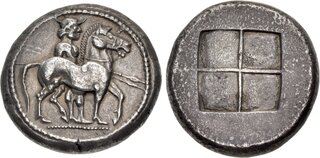| Classical Numismatic Group > Auction 126 | Auction date: 28 May 2024 |
| Lot number: 123 Price realized: This lot is for sale in an upcoming auction - Bid on this lot  | Show similar lots on CoinArchives Find similar lots in upcoming auctions on |
| Lot description: KINGS of MACEDON. Alexander I. 498-454 BC. AR Tristater – "Oktadrachm" (30.5mm, 28.43 g). Light Aeginetic standard. Aigai mint. Struck circa 476/5-460 BC. Horseman, wearing chlamys and petasos, and holding two spears, standing right behind horse advancing right / Quadripartite incuse square. Raymond pl. II, 4; AMNG III p. 49, 7 (Bisaltai); HPM pl. XII, 2 (Bisaltai); SNG ANS 1; Athena Fund I 21 (same obv. die); Boston MFA 617 (Bisaltai); Gillet 739; Pozzi 696 = Rhousopoulos 1006 (Bisaltai). Attractive cabinet tone. EF. From the Wild Rose Collection. Ex Triton XXII (8 January 2019), lot 185; Osaka Collection (Hess-Divo 334, 29 May 2018), lot 40, assembled prior to 2000. By the end of the sixth century BC, the Kingdom of Macedon became an influential regional power, strategically located between the Persian Empire and the city-states of Greece. The wars with Persia further extended Macedon's importance, especially that of its young prince, Alexander I, the son of Amyntas. An astute politician, Alexander deftly maneuvered through this precarious situation. Although he early on offered his sister's hand in marriage to a Persian to offset punishment for his revenge against the high handedness of a Persian embassy in 514-513 BC, Alexander maintained an aloof but cordial relationship with the Persians as they moved through the region in 492 BC, forcing the other tribes to Medize. At the same time, he worked towards a stronger association with the Greeks. Herodotos (9.44) says that on the eve of the battle at Plataia, Alexander entered the Athenian camp to report that a delay in engaging the Persians would help to further diminish their already low supplies. In return, he hoped the Greeks (in particular the Athenians) would assist him when the time came, thereby forging a relationship between the rising power in the north with the rising Greek city-states of Athens, Sparta and their allies. This coin type had long been ascribed to the Bisaltai, one of the powerful Thraco-Macedonian tribes that struck coinage in the late 6th and early 5th centuries. The weight of the evidence now points to it being the earliest issue of Alexander I, when he was allied with the tribes against the Persians; he presumably struck coins with types that were acceptable to his allies and would, in fact, symbolize their alliance. For a discussion of the weight standard of this issue, see S. Psoma, "Did the So-Called Thraco-Macedonian Standard Exist?" in KAIPOΣ, pp. 167–90. Estimate: 10000 USD |  |



